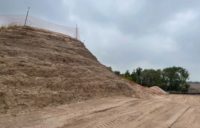The U.S. Supreme Court has agreed to hear a case this term that could affect whether states must pay compensation to landowners whose property was damaged by public project execution. Payments also could extend to state owned utilities and others.
At issue is a claim by Texas property owners that the state must pay for flood damage attributed to Texas Dept. of Transportation design of a highway overpass that caused the structure to act as a dam and trap rainwater both from 2017's Hurricane Harvey and 2019's Tropical Storm Imelda—blocking the water from flowing away from their properties.
Texas Attorney General Ken Paxton is asking the high court to review whether the “takings” clause in the U.S. Constitution—which originally applied only to the federal government but was applied to states through the 14th Amendment—enables the owners to bring an action against a state.
Texas says it is immune from paying compensation. The U.S. Appeals Court in New Orleans agreed in a recent decision that property owners could only sue the state for damages if Congress passes a law allowing it. But the federal appellate court in Boston ruled separately that "just compensation" as guaranteed by the Bill of Rights cannot be limited or diminished—even by law—setting up a conflict that requires the Supreme Court to settle.
In its original complaint filed in 2021 against the Texas Dept. of Transportation in state court, the plaintiffs claimed Interstate 10 in Chambers and Jefferson counties was designed to raise highway elevation to widen I-10 to six lanes, with a solid concrete traffic median barrier down the centerline to facilitate use as an storm evacuation route.
But plaintiffs claim the effect of the solid wall was a taking by flooding—an action that damaged and destroyed their property due to the state’s design, construction, operation and maintenance of I-10.
The barrier was installed in sections and grouted together for a complete seal and does not have slots to allow water to pass between the north and southbound lanes.
According to the complaint, the state knew the installation of a solid concrete traffic median would block rainfall but altered drainage plans prepared by its contractors knowing it would decrease that drainage.
"The permanent placement of an impenetrable traffic median barrier/dam down the center of I-10 guarantees that the flooding of plaintiffs’ properties will inevitably reoccur, as when Imelda followed Harvey only two years later," the landowners charge. "Each and every one of [property impacts claimed] were not only severe but also reasonably foreseeable to the state because of the design, construction and maintenance of the median barrier."
The damage amount sought, which was not stated, will be determined by a lower court if justices rule for the owners.
'Inverse Condemnation'
Most eminent domain compensation is paid when the government condemns land, but in this case the damage is considered an “inverse condemnation”—meaning the land was not condemned but damaged by later actions. California has seen such lawsuits against utilities for wildfires caused by downed powerlines.
The Pacific Law Center, a legal advocacy group for property rights that petitioned the high court to take the case for the plaintiff, said the high court could resolve the confusion by holding that the Constitution’s “just compensation clause” is “self-executing.” That means states may not immunize themselves from the constitutional mandate to pay the compensation.
The high court has previously said that the clause is meant to secure compensation, says the center. “When government takes property, it is obligated to provide just compensation,” it says. If government does not, property owners are entitled to seek compensation themselves without additional government permission.
The legal group says the court should “ensure that property owners have a means for constitutional redress against any government actor—local, state, or federal—that takes private property for public use without just compensation.”
Texas argued, however, that Congress has not provided "a cause of action” to enforce the 14th amendment or the takings clause by seeking monetary compensation from states, said a statement released by Paxton.
GHG Metrics Challenge Rejected
Meanwhile, the high court declined on Oct. 11 to overturn a lower court’s ruling that 11 Republican-led states lacked standing to challenge the Biden administration’s formula to determine the interim cost of greenhouse gas emissions.
The justices did not explain their denial. Their lawsuit was led by Missouri Attorney General Andrew Bailey, who said the challenge would still continue.
Judges in two lower courts who rejected the case said the states could challenge the formula and the resulting prices once they are included in future federal regulations and actual harm can be claimed.
The states challenged the rejection by the U.S. appeals court in St. Louis of their abstract claim of harm. The 11 states claimed the interim rule would eventually expand federal regulatory burdens once they were adopted by federal agencies.
Arkansas, Indiana, Kansas, Montana, Nebraska, Ohio, Oklahoma, South Carolina, Tennessee and Utah also were plaintiffs in the case.
The George W. Bush administration was the first to use an estimate of the social cost of greenhouse gases in analysis of major construction projects. The estimate is derived from climate science and economics to determine the long-term damage of the emissions and their effect on climate change.
The Obama Administration set an interim value of one metric ton of carbon at $43 while a final value is being determined. The Trump Administration cut it to $1 and President Joe Biden raised it to the Obama value adjusted for inflation—$51.
The U.S. Environmental Protection Agency has proposed increasing the cost of carbon to $190 per metric ton. That number is expected to be finalized next year.






Post a comment to this article
Report Abusive Comment